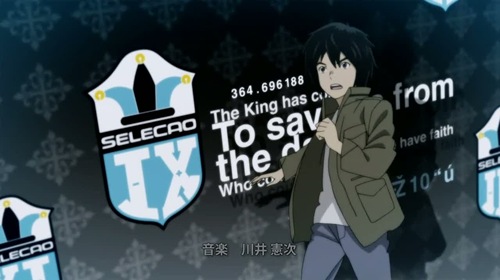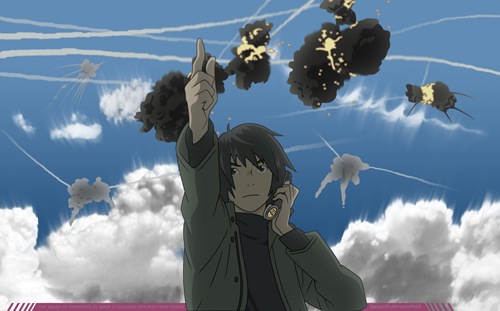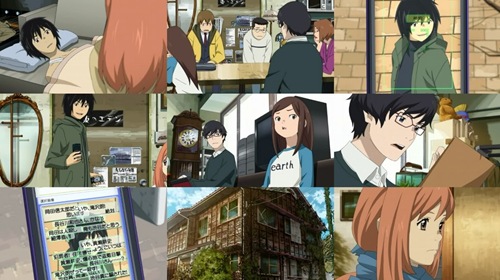Eden of The East : Warning!! Spoil
Eden of the East
Title: Eden of the East aka Higashi no Eden
Genre: Drama/Romance
Company: Production I.G.
Format: 11 episodes
Dates: 10 Apr 2009 – 19 Jun 2009
Synopsis: Morimi Saki has just graduated and is on an overseas trip with her friends in the United States. A detour from her group to see the White House, a place which she sees as the centre of the earth because of its influence on world affairs, gets her involved in an incident with the police and a strange naked man wielding a gun and a mobile phone. This man, Takizawa Akira, has amnesia, and his phone holds the key to a mystery… one that relates to a spate of recent missile attacks on Japanese soil.

The Highlights
Animation: Maintains Production I.G.’s reputation for quality.
Character designs: Umino Chika’s character designs complement a unique style.
Music: A typically excellent soundtrack from Kawai Kenji.
OP and ED sequences: Unique and creative, like the show in general.
Themes: An analysis of the interplay between politics, society and technology.
Characters: Akira is enigmatic and sympathetic.
Romance: Stalls a tad in the latter part.
Ending: Not yet… wait for the movies.

When it’s done right, the mystery genre can produce some of the most absorbing and unique stories in anime. Eden of the East is a fine example of the mystery genre done right, and it’s utterly captivating from its first few minutes. However, as the story evolves, it not only becomes more intricate, it also strives for relevance, making commentaries on politics, society and the corporate structure in Japan. All this is done with production values that are simply gorgeous: the animation is technically proficient, but Umino Chika’s character designs also lend it a quality of sweet charm and charisma. My only major complaint can almost be seen as a good thing: with the hanging ending, comes confirmation that there’s still more to come.
There’s so much polish to the aesthetics of this anime. Production I.G. have a remarkable history of pushing the limits of animation, as can be seen with an extensive catalogue of visual feasts like FLCL, Blood: The Last Vampire and Ghost in the Shell: Stand Alone Complex. Eden of the East is similarly visually delightful but rather than trying to outdo its predecessors for motion and vibrancy, Eden is more concerned with forging an aesthetic identity to call its own. Combined with rich and colourful backgrounds are character designs by Umino Chika which are patently moe and instantly recall memories of Honey and Clover. It allows director Kamiyama Kenji to add both humour and humanity to his characters (for example, he often employs the somewhat antiquated technique of giving his characters visible emotion bubbles), making them both more sympathetic and intriguing.

This is offset by Kawai Kenji’s solemn soundtrack, which does a great job of keeping up a serious and mysterious atmosphere. On the topic of music, even the OP and ED complement Eden’s aesthetic sensibilities in a unique way: the ED sequence, set to School Food Punishment’s “Futuristic Imagination”, is a paper stop motion animation featuring pencils as missiles and a symbolic summary of the story, while the OP sequence, filled with vibrant, fast moving images, words, colours and patterns and the music of Oasis, leads us to the inevitable conclusion that someone’s thrown serious money at this anime (but that’s hardly a first for Production I.G.).
![[large][AnimePaper]wallpapers_Eden-of-the-East_Bu-Chan(1_6)__THISRES__101509 [large][AnimePaper]wallpapers_Eden-of-the-East_Bu-Chan(1_6)__THISRES__101509](https://etccafes.files.wordpress.com/2011/01/largeanimepaperwallpapers_edenoftheeast_buchan1_6__thisres__1015091.jpg?w=500&h=311)
Barring a slightly off-putting obsession with “Johnnies”, the script is excellent. The mystery throws up its fair share of memorable curveballs, particularly towards the end, but its strength is in the relevant commentaries that come from its themes. At several points an analysis of public opinion in the face of terrorism, crisis and political and technological upheaval, Eden is at its strongest when its denouncing the rigidness of the corporate culture in Japan, and its requirements of loyalty and, ultimately, identity, and how many of the most creative and innovative individuals are stifled and eventually cast off by the established system. There’s also an analysis of the pros and cons of concentrating power in the hands of few, and how this influences change on a local and national level.
Unfortunately this is a story that’s far from over, with numerous questions, especially surrounding the “Supporter” and Mr. Outside, still remaining. This incarnation has built up my expectations for what has to follow, but what I really want to see is Saki take a more active role in the story. Initially an interesting character, by the end she falls into the role of a normal person observing a world beyond her comprehension. More romance between her and Akira would be nice too; they share one incredibly romantic moment about half way through, but after that their relationship stalls. Akira, fortunately, offsets this by being an incredibly captivating and enigmatic character, one of the real strengths of this show. Eden makes the point that he is a prince, and the TV series documents his rise. Fortunately, with two movies promised already, it won’t be a long wait before we see his reign.

Eden of The East the Movie II: Paradise Lost
Description:
ten missiles strike Japan. However, this unprecedented terrorist act, later to be known as "Careless Monday," does not result in any apparent victims, and is soon forgotten by almost everyone. Then, 3 months later... Saki Morimi is a young woman currently in the United States of America on her graduation trip. But just when she is in front of the White House, Washington DC, she gets into trouble, and only the unexpected intervention of one of her fellow countrymen saves her. However, this man, who introduces himself as Akira Takizawa, is a complete mystery. He appears to have lost his memory. and he is stark naked, except for the gun he holds in one hand, and the mobile phone he's holding with the other hand. A phone that is charged with 8,200,000,000 yen in digital cash.
The King Of Eden The first Eden of the East movie is out and near as I can tell not much actually happened. Still I’m glad I got to finally see it, I really love the animation used, the attention to detail is unmatched in my experience. Hopefully more will happen in the second movie, this one leaves a lot of loose ends.
The second film, Eden of The East the Movie II: Paradise Lost
Nine years ago, the words ‘terror’ and ‘terrorist’ took on an entirely new significance for many Americans, including myself. Personally, prior to 9/11, whenever the word terrorist came up, I thought of the ‘bad future’ in Back to the Future Part II, in which Biff Tannen rose to power by using the Sports Almanac to win all the bets. I shit you not. Who was it, the principal guy, who Marty runs into (and ends up on the wrong end of his shotgun) who refers to these guys terrorists. They were guys who show up in a burnt-out beater, fill your house full of bullet holes, and are gone as soon as they arrive. But neither Marty nor the principal are injured by the attack. The ‘terrorists’ were fearsome, but somehow, they were also a joke. The film Brazil takes a similar, dark comedic tack to terrorists as more of a nuisance to the people than a real threat. Eden of the East throws around the terms ‘terror’ and ‘terrorist’ in way that makes me recall those other films.
In the world of Eden of the East, it denotes individuals or groups who engage more in mischief than terror, or at most, the threat of death and destruction, while delivering only destruction at best. Such was the Careless Monday incident that took place prior to the timeline of the show or its two sequel films: a big hole in Tokyo was made, but no casualties. It makes you wonder as well as wish that the World Trade Center site had been totally devoid of people when the attacks took place. After all, it is the lives we mourn the most by far, not the structures. Still, New York is and always will be conspicuous in the towers’ absense, even if they’re replaced by newer, shinier, taller skyscrapers. Even if there hadn’t been any people in or around the towers when they fell, their falling would have still caused a shock.
The Seleção, operating under the motto “Noblesse Oblige” share a lot of qualities with terrorists. They operate in secret for the most part, with large amounts of funds at their disposal. They act unilaterally and outside the constraints of the law. They are deemed ‘noble’ by their benefactor, Mr. Outside; all terrorists believe they’re noble. And their goal is to improve the nation and become its messiah. Improving it to their specs, based on their impressions of that nation’s society, mind you. Without their input or consent. All of this is fairly innocent compared with mass murder, but its well within their means to kill lots of people with the resources on hand. Thankfully, this series doesn’t take so dark a turn, and this doesn’t happen. Whew…sorry about that! Anywho, Eden of the East: Paradise Lost, a film that follows The King of Eden and completes the story begun in the original anime, which not only had my favorite opening credit sequence to date, but had one of the best starts of all the anime I’ve seen. The series and these films never really reached the same stratospheric highs of those first episodes, but remained above average, solid storytelling. New York of the not-too-distant future. As usual, this film is chock full of surprisingly accurate settings: I’ve visited Tokyo between the two Eden films, and in this second one, I noticed the characters were in Chuo, Shibuya, Odaiba, Toyosu, and Sakuradamon.
The detail of the settings are impressive and lend the film the same immer sive quality of the series. I also enjoyed the character design of the Eden franchise, particularly the adorable Saki and the fat NEET computer genius. The romance between Akira and Saki gets little play in the film, as the two are separated for most of it, but everything Saki does is for Akira’s sake. It may not be in your face, but her love and concern does show through in the film. The film also takes a few cracks at modern Japanese society, courtesy of arguably the shrewdest but most cynical of the Seleção. ‘This is a nation of 100 million egoists…prime ministers are nothing but scapegoats,’ he says. To a degree, that’s true. They had just switched PMs the week I visited; not because of any scandal or crime, but simply due to not fulfilling a campaign promise. Our President has used the previous president as a scapegoat for most of our problems, and he will be used as a scapegoat by his eventual successor, so I guess Japan isn’t alone here; but a change of leaders happens more often there than here since ours can break promises for eight years and not step down. That same cynical Seleção would also consider the American Dream an encumbrance to a nation’s success: ‘citizens are parts for improving a nation,’ nothing more; and be believes individuality is an inconvenience to that nation. ‘It is impossible for everyone to become someone,’ he says, exposing his narrow understanding of society.
Japan may seem conservative on some levels, but nobody can doubt that the ambitions of individuals have helped more than harmed both Japan and the states. Finally, Japan is on the same level of development and prosperity as America, which means, inexorably, there’ll a certain section of society doing absolutely nothing. NEET may be a term coined in Japan, but there may be more NEETS in America. There are probably also more NEETs in both countries than there are ‘chosen’ individuals whose circumstances have in one way or another led them to live lives of privilege and obligation
– in other words, nobility. It stands to reason the NEETS would outnumber the nobles. Seleção IX, or Akira, believes he’s been given the power to shake the nation like a tree until all the NEETS come out, then inspire them to put their NEETness to use improving their nation. The Seleção’s AI concierges may refer to their masters as messiahs, but IX and Mr. Outside seem to agree that losers are the real saviors of society, despite everyone else’s revulsion to them. It’s true that it’s impossible for everyone to become someone. But I don’t want to live in a world where nobody tries.
Review
The return of Kenichi: The Mightiest Disciple
—————
Ao no Exorcist
—————
Beelzebub
—————
Gintama
—————
Gintama: anime/manga mentions or illustrates
—————
Heroic Age
—————
Kimi ni Todoke
—————
Rurouni Kenshin
—————
Ichiban Ushiro no Daimaou
—————
Togainu no Chi
—————










__THISRES__186768.jpg)



